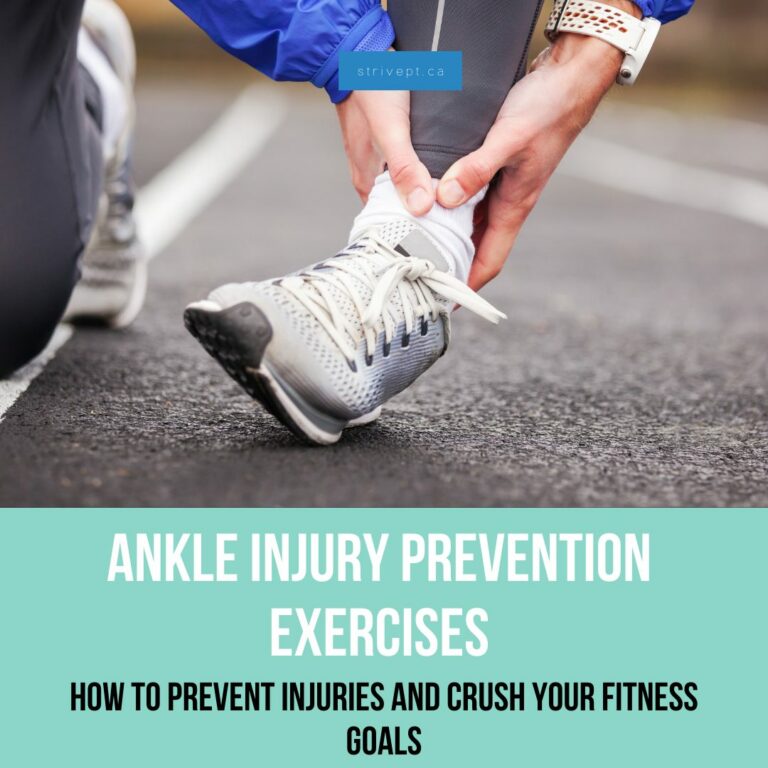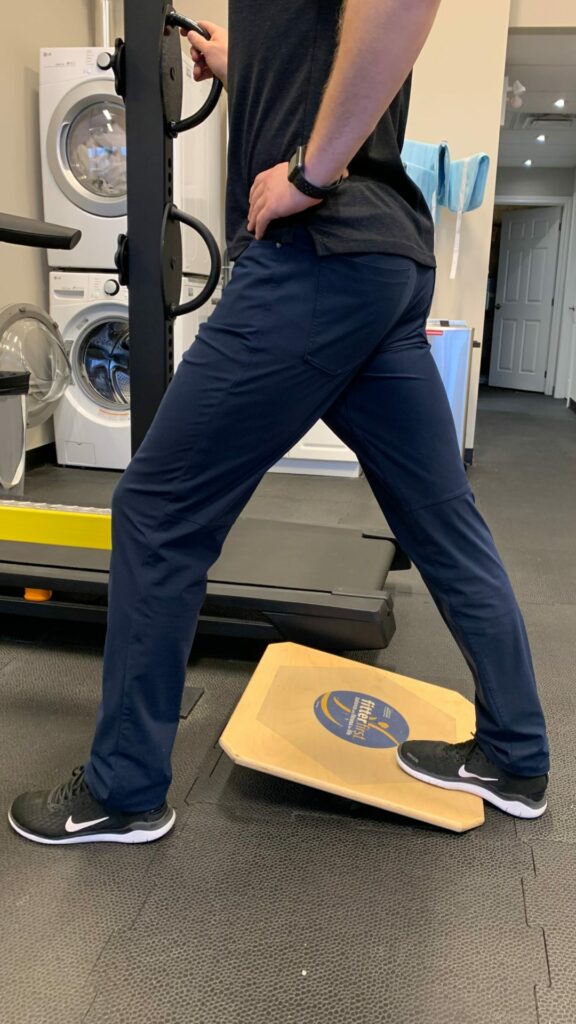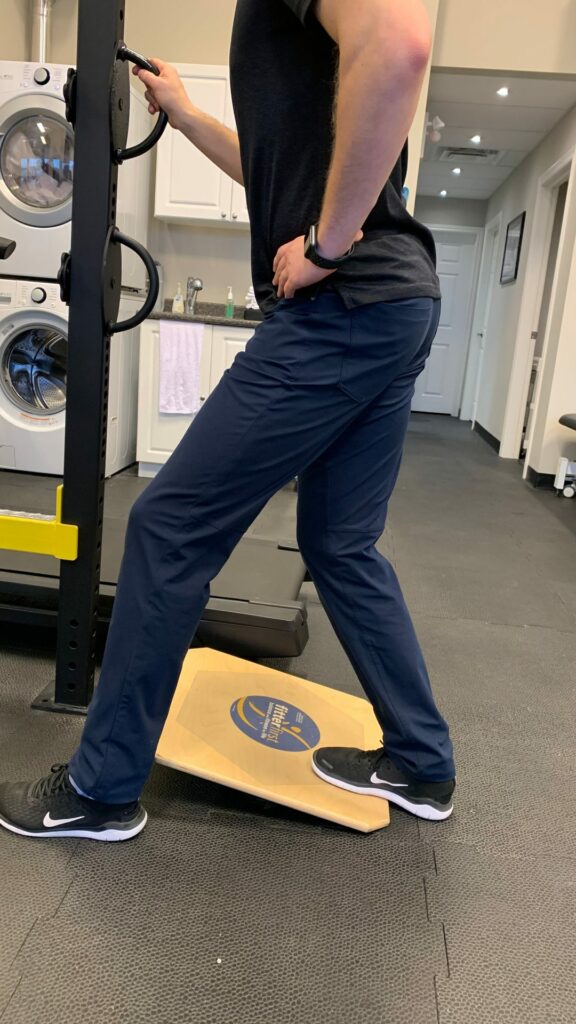
Let’s be honest, 2020 sucked. The COVID-19 pandemic closed our gyms, cancelled our sports, and made take-out food substantially more enjoyable. This translated to a “go-nowhere-do-nothing-eat-everything” lifestyle, and chances are we’ve put on a few “pandemic pounds” or the “COVID-10”, if you will. But we’ve made it to 2021, and it’s time to get our fitness levels back on track – even if our gyms are still closed!
Unfortunately, quickly getting active comes with an injury risk, and if you’re going to sustain an activity-related injury, it’s most likely going to be ankle-related. That’s because the ankle is the most commonly injured body part – accounting for up to 30% of all sports-related injuries (1). Not surprisingly, it is also the most commonly re-injured body part (2). This blog will show you some ankle injury prevention exercises so you can kick that COVID-10 and return to your normal, healthier lifestyle.
Your Ankle
Your ankle is a super mobile joint! It can plantarflex (point your toes), dorsiflex (pull your foot up), invert (turn inwards), and evert (turn outwards). That creates A LOT of different movements!
This is great news, and super helpful as it allows us to perform a high number of activities at a variety of speeds. Humans can run, jump, make sharp turns, climb stairs, kick balls, balance on uneven surfaces – and our ankle joint is a pinnacle part of our success.
With great power comes great responsibility – if we have a lot of mobility, then we need a lot of strength and control. Luckily, exercise programs “are effective at reducing the rate of ankle sprains… particularly [in] those with a history of ankle sprain” (3). That being said, it’s important to note that there’s no 100% fool-proof way to prevent ankle injuries – sometimes, accidents just happen. However, if you want to give yourself the best chance of success, read on.
Ankle Injury Prevention Exercises
The ideal training program for preventing an ankle injury includes exercises to work on range of motion (ROM), strength, and proprioception/control (proprioception is your body’s unconscious awareness of where you are in space). Here’s a few exercises for each.
Start with working on your ankle mobility and range of motion. A great way to do this is a “Triplanar Dorsiflexion Stretch” seen here:
Setup: Stand in a staggered-stance with the ankle you want to mobilize as the front leg. Movement: Keeping your heel on the ground, and your toes forward, lean forward to encourage your ankle to bend. Practice repetitions in a straightforward direction, repetitions where your knee comes inside your toes, and repetitions where your knee goes outside your toes. Tip: Use a post, or stick (like in the video) to have something to aim at. Do 5-10 repetitions in each of the 3 directions, and repeat 2-3 times. |
General calf stretching can also help you feel like you’ve gained a bit of mobility. There are two main muscles in your calf complex – the gastrocnemius, and the soleus. Here’s the set up for stretching them:
Setup: Begin in a standing position with your feet in a staggered stance, holding onto a stable surface for support. Place your back foot up on a wedge.
Movement: Keeping your back knee straight, push your hips forward. You will feel a stretch in the back of your lower leg.
Tip: Make sure to keep both feet pointed straight forward and flat on the ground during the stretch
Setup: Begin in a standing position with your feet in a staggered stance, holding onto a stable surface for support. Place your back foot up on a wedge.
Movement: Keeping your back knee slightly bent, lean forward. You will feel a stretch in your lower calf and hold.
Tip: Make sure to keep your heels on the ground and back knee bent during the stretch.
Note: Placing your foot on a wedge simply increases the stretch, but it’s not completely necessary.
Do 3 repetitions of 30-45 seconds on each leg, for each stretch.
After you’ve worked on your ankle mobility, it’s important to load it! To “load it” simply means use it! Do some weight bearing ankle movements, like this Y-balance exercise:
Setup: Stand balancing on 1 leg.
Movement: Keeping your balance on 1 leg, reach forward with your other leg as far as you can without losing your balance/control. Return to the starting point then reach backward/outward as far as comfortable, then backward/inward as far as comfortable.
Tip: Try not to put your hands on your legs, and focus more on control than overall reach distance!
Note: This is also a great starting point for working on your balance, proprioception, and control!
Start by trying to do 5 “Y’s” on each leg, then repeat 3 times per side. Increase the number of “Y’s” you do as you improve!
Now that you’ve started working on your balance and control, lets step it up a notch and challenge these systems a little further. Here are two great exercises to challenge your balance!
Setup: Stand on one leg with a kettlebell in one hand. Bend your knee slightly so that the kettlebell is below your knee.
Movement: Toss the kettlebell back and forth while maintaining your balance.
Tip: Maintain a sturdy balance, and keep the kettlebell below your knee.
Setup: Stand on one leg on an uneven surface.
Movement: Toss a ball back and forth with another person (or you can throw the ball off a wall and catch it).
Tip: Keep a slight bend in your knee, and focus on good control.
Start by doing each exercise for 3 sets of 30 seconds per leg. Increase the time as you improve!
Finally, it’s important to build ankle strength! The primary focus should be your peroneal muscles (muscle on the outside of your ankle) and your calf muscles. Here are some simple exercises to get you started!
Setup: Begin in a standing upright position.
Movement: Lift one foot off the ground to balance on your other foot. When you are balanced, slowly raise your heel off the ground, then lower it back down and repeat.
Tip: Make sure to maintain your balance during the exercise and do not let your ankle rotate to either side.
Setup: Begin sitting upright on the floor with a resistance band secured around one foot. The resistance band should be looped around the bottom of your other foot with the end held in your hand.
Movement: Move the foot with the resistance band away from the other foot by rotating your ankle outward, then slowly return to the starting position and repeat.
Tip: Make sure to avoid any hip or knee movement. You can sit on a chair if it’s more comfortable.
Start with 3 sets of 10-15 repetitions for each exercise. Increase the number of repetitions, or hold weight (heel raises)/increase band tension (eversion exercise) as you improve!
And there you have it! A simple exercise program to help prevent an ankle injury and to keep you active through 2021 and beyond! Be sure to check out our blog page for a plethora of additional information on things like pain, athletics, and post-surgical care. You can also check us out on Facebook and Instagram for more daily tips!
If you have an ankle injury, or would simply like some one-on-one help with your injury prevention program, reach out to a physiotherapist. A physiotherapist can assess your individual situation and teach you the safest exercises for you. At Strive Physiotherapy & Performance, we are committed to providing an in-depth assessment to ensure we can work together to find the best plan of action for each individual client.
Call us at 519-895-2020, or use our online booking tool on www.strivept.ca to book an appointment with one of our knowledgeable physiotherapists, and they will be sure to help you understand your injury.
Take good care,
Tyler Allen
Physiotherapist at Strive Physiotherapy & Performance
References:
- Olsen, O. E., Myklebust, G., Engebretsen, L., Holme, I., & Bahr, R. (2005). Exercises to prevent lower limb injuries in youth sports: cluster randomised controlled trial. Bmj, 330(7489), 449.
- Welton, K. L., Kraeutler, M. J., Pierpoint, L. A., Bartley, J. H., McCarty, E. C., & Comstock, R. D. (2018). Injury recurrence among high school athletes in the United States: a decade of patterns and trends, 2005-2006 through 2015-2016. Orthopaedic journal of sports medicine, 6(1), 2325967117745788.
- Schiftan, G. S., Ross, L. A., & Hahne, A. J. (2015). The effectiveness of proprioceptive training in preventing ankle sprains in sporting populations: a systematic review and meta-analysis. Journal of science and medicine in sport, 18(3), 238-244.

